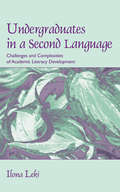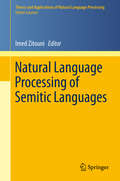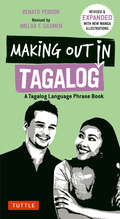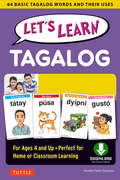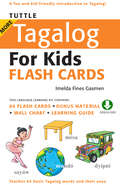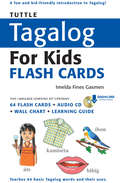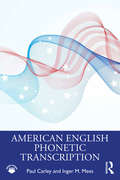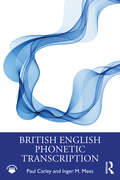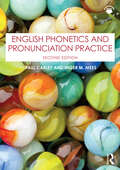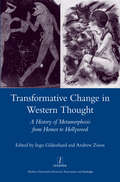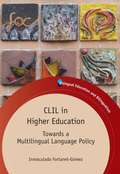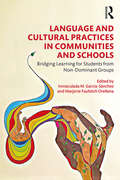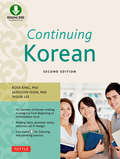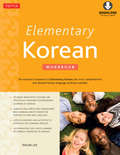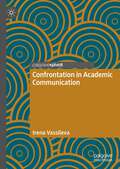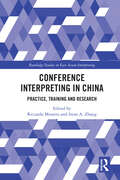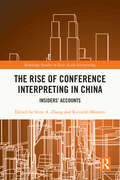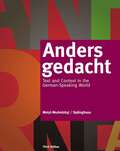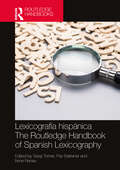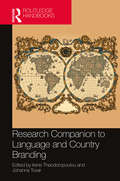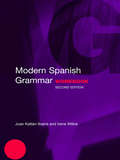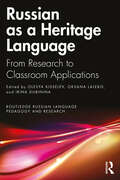- Table View
- List View
Undergraduates in a Second Language: Challenges and Complexities of Academic Literacy Development
by Ilona LekiThis is the first book-length study of bilingual, international, and immigrant students in English writing courses that attempts to fully embed their writing experiences within the broader frame of their personal histories, the human context of their development, and the disciplinary contexts of their majors. It addresses the questions: How useful are L2 writing courses for the students who are required to take them? What do the students carry with them from these courses to their other disciplinary courses across the curriculum? What happens to these students after they leave ESL, English, or writing classes? Drawing on data from a 5-year longitudinal study of four university students for whom English was not their strongest/primary language, it captures their literacy experiences throughout their undergraduate careers. The intensive case studies answer some questions and raise others about these students’ academic development as it entwined with their social experiences and identity formation and with the ideological context of studying at a US university in the 1990s.
Natural Language Processing of Semitic Languages
by Imed ZitouniResearch in Natural Language Processing (NLP) has rapidly advanced in recent years, resulting in exciting algorithms for sophisticated processing of text and speech in various languages. Much of this work focuses on English; in this book we address another group of interesting and challenging languages for NLP research: the Semitic languages. The Semitic group of languages includes Arabic (206 million native speakers), Amharic (27 million), Hebrew (7 million), Tigrinya (6. 7 million), Syriac (1 million) and Maltese (419 thousand). Semitic languages exhibit unique morphological processes, challenging syntactic constructions and various other phenomena that are less prevalent in other natural languages. These challenges call for unique solutions, many of which are described in this book. The 13 chapters presented in this book bring together leading scientists from several universities and research institutes worldwide. While this book devotes some attention to cutting-edge algorithms and techniques, its primary purpose is a thorough explication of best practices in the field. Furthermore, every chapter describes how the techniques discussed apply to Semitic languages. The book covers both statistical approaches to NLP, which are dominant across various applications nowadays and the more traditional, rule-based approaches, that were proven useful for several other application domains. We hope that this book will provide a "one-stop-shop'' for all the requisite background and practical advice when building NLP applications for Semitic languages.
Making Out in Tagalog: A Tagalog Language Phrase Book
by Renato Perdon Imelda F. GasmenMaking Out in Tagalog is your indispensable guide to contemporary Tagalog language (Filipino) as it's really spoken on the streets of Manila.This best-selling Tagalog phrase book is the perfect introduction to everyday interactions in The Philippines and other Tagalog-speaking countries, and includes colorful slang that'll help rev up your social life. A great way to learn Tagalog, Making Out in Tagalog features a pronunciation guide, and notes on Tagalog language and culture. With Making Out in Tagalog you'll be able to express yourself when: Making new friends Sharing a meal Going out on the town Flirting and getting amorous And much more!Each expression in this book is given in Tagalog and their English translations. It is designed to enhance your experience in using the language (and in a pinch, you can show the Tagalog text to the person you're speaking to). Making Out in Tagalog also includes interesting tips on social norms and cultural practices, eating, social media, hanging out, and other situations. For the savvy traveler, this is a Tagalog phrasebook you won't want to be without!
Let's Learn Tagalog: 64 Basic Tagalog Words and Their Uses-For Children Ages 4 and Up
by Imelda Fines GasmenLet's Learn Tagalog Kit is a complete language learning tool specially designed to introduce young children to the basic Tagalog sounds, words, and phrases in a fun and interactive way. <P><P> This kit is perfect for use in a classroom setting, for home schooling, on vacation, or anywhere else that learning takes place. It is intended for learners who have little or no background in the Tagalog language. It contains: 64 flash cards An audio CD with recordings of words, sentences and songs A wall chart showing the main words and phrases at a glance A 32-page Learning Guide for parents and teachers The 64 words are organized into thematic categories, including: My Family Colors Numbers Animals Food My Body Clothes My Day Each word is illustrated with a picture that serves as an effective visual aid to learning and remembering the word. The words often reflect cultural objects and can be studied in any order. Tagalog language learners may focus on one theme at a time or mix them up for greater variety. Simple example sentences are given for each word to show how they are used. The audio CD gives native-speaker pronunciations for all the words and sentences and also contains songs which promote interactive language learning. Finally, the kit includes a wall chart featuring all the pictures and words, and some bonus words; a booklet explaining how to use the flash cards, and additional activities; an audio CD and a wall chart.
Tuttle More Tagalog for Kids Flash Cards
by Imelda Fines GasmenA fun and kid-friendly introduction to Tagalog!The Tuttle MORE Tagalog for Kids Flash Cards is an introductory language learning tool especially designed to help children from preschool through early elementary level acquire basic words, phrases, and sentences in Tagalog-the official language of the Philippines- in a fun and easy way.<P><P>The flashcards can be used as a learning tool in a classroom setting, at home, or anywhere that learning takes place, and can easily be taped around the room for an interactive learning experience. The set contains a total of 64 words organized into thematic categories, including: Nature, Weather, Opposites, Actions, Things I Like To Do, At My House, and Going to Different Places. All of the words are illustrated-the pictures serve as effective visual aids to help children learn and remember each word's meaning. Words often reflect cultural objects and items and can be studied in any order. Learners may focus on one theme at a time or mix them up for a little more variety.Also included is downloadable audio which provides native pronunciation of the words, and sample sentences for practice-sentences that children would use in everyday life. Songs and other activities are also included along with a wall chart featuring the front of each card for kids to review and a learning guide for teachers and/or parents with tips, activities and more!If your child is really interested in learning more words, and you missed the first one, check out the Tuttle Tagalog for Kids Flash Cards (978-0-8048-3957-0).
Tuttle Tagalog for Kids Flash Cards Kit
by Imelda Fines GasmenA fun and kid-friendly introduction to Tagalog!<P><P>The Tuttle Tagalog for Kids Flash Cards kit is an introductory language learning tool especially designed to help children from preschool through early elementary level acquire basic words, phrases, and sentences in Tagalog in a fun and easy way.The flashcards can be used as a learning tool in a classroom setting, at home, or anywhere that learning takes place. The set contains a total of 64 words organized into thematic categories, including: My Family, Colors, Numbers, Animals, Food, My Body, Clothes, and My Day. All of the words are illustrated-the pictures serve as effective visual aids to help children learn and remember each word's meaning. Words often reflect cultural objects and items and can be studied in any order. Learners may focus on one theme at a time or mix them up for a little more variety.A downloadable audio CD provides native pronunciation of the words, and sample sentences for practice, as well as songs and other activities. Also included is a wall chart featuring the front of each card for kids to review and a learning guide for teachers and/or parents with tips, activities and more!
American English Phonetic Transcription
by Inger M. Mees Paul CarleyAmerican English Phonetic Transcription provides an accessible introduction to phonemic, phonetic, and intonational transcription with a focus on American English. Featuring exercises, revision tasks, and recordings to help students gain hands-on practice, the book takes a learning-by-doing approach and ensures students gain practice using each new symbol or concept introduced before moving on to the next. Consisting of three parts, the book covers: transcribing individual words, including consonants, vowels, primary stress, secondary stress, syllabic consonants, and inflections; transcribing phrases and sentences, including weak forms, elision, and assimilation; transcribing intonation, including the structure of English intonation and recognizing pitch patterns. Ideally suited as a standalone workbook or for use alongside British English Phonetic Transcription, American English Phonetic Transcription is key reading for undergraduate students of linguistics as well as anyone teaching or learning English as a foreign language.
British English Phonetic Transcription
by Inger M. Mees Paul CarleyBritish English Phonetic Transcription provides an accessible introduction to phonemic, phonetic and intonational transcription with a focus on British English. Featuring exercises, revision tasks and recordings to help students gain hands-on practice, the book takes a learning-by-doing approach and ensures students gain practice using each new symbol or concept introduced before moving on to the next. Consisting of three parts, the book covers: transcribing individual words, including consonants, vowels, primary stress, secondary stress, syllabic consonants and inflections; transcribing phrases and sentences, including liaison, weak forms, elision and assimilation; transcribing intonation, including the structure of English intonation and recognising pitch patterns. Ideally suited as a standalone workbook or for use alongside American English Phonetic Transcription, British English Phonetic Transcription is key reading for undergraduate students of linguistics as well as anyone teaching or learning English as a foreign language.
English Phonetics and Pronunciation Practice
by Inger M. Mees Paul CarleyEnglish Phonetics and Pronunciation Practice provides a unique introduction to basic articulatory phonetics for students of English. Taking a practical approach, this book teaches the pronunciation of modern standard non-regional British English to intermediate and advanced learners worldwide.Now fully updated and restructured, the more concise new edition:• provides an up-to-date description of the pronunciation of modern British English;• demonstrates the use of English consonants and vowels in a variety of contexts and in contrast with other sounds with which they may be confused;• includes expanded theory sections for an improved balance of theory and practice;• is supported by extensive online audio material.Ideal for studying pronunciation in the classroom or for independent student practice, English Phonetics and Pronunciation Practice is essential reading for any student of pronunciation and phonetics.
Transformative Change in Western Thought: A History of Metamorphosis from Homer to Hollywood
by Ingo GildenhardThis groundbreaking volume maps the shifting place and function of marvelous transformations from antiquity to the present day. Shape-shifting, taking animal bodies, miracles, transubstantiation, alchemy, and mutation recur and echo throughout ancient and modern writing and thinking and continue in science fiction today as tales of gene-splicing and hybridisation. The idea of metamorphosis lies in uneasy coexistence with orderly world views and it is often cast out, or attributed to enemies. Augustine and the church fathers consider shape-shifting ungodly; Enlightenment thinkers suppress alchemy as unscientific; genetically-modified wheat and stem-cell research are stigmatised as unnatural. Yet the very possibility of radical transformation inspires hope just as it frightens. A provocative, theorising, trans-historical history, this book ranges across classics, literature, history, philosophy, theology and anthropology. From Homer and Ovid to Proust and H. P. Lovecraft and through figures from Proteus to Kafka's Fly and toSpiderman, four historical surveys are combined with nine case studies to show the malleable, yet persistent, presence of transformation throughout Western cultural history.
CLIL in Higher Education
by Inmaculada Fortanet-GomezThis book offers a unique view of multilingualism in higher education from a global perspective. It presents a contextualised case of a multilingual language policy which takes the Content and Language Integrated Learning (CLIL) approach. The volume discusses various approaches to multilingual education including CLIL and then proposes guidelines for a multilingual language policy for Universitat Jaume I in Castelló, Spain. It examines the advantages of a multilingual education programme and reviews the success of existing language policies. This book will be an essential resource for researchers and students as well as policy makers.
Language and Cultural Practices in Communities and Schools: Bridging Learning for Students from Non-Dominant Groups
by Inmaculada M. García-Sánchez Marjorie Faulstich OrellanaDrawing on sociocultural theories of learning, this book examines how the everyday language practices and cultural funds of knowledge of youth from non-dominant or minoritized groups can be used as centerpoints for classroom learning in ways that help all students both to sustain and expand their cultural and linguistic repertoires while developing skills that are valued in formal schooling. Bringing together a group of ethnographically grounded scholars working in diverse local contexts, this volume identifies how these language practices and cultural funds of knowledge can be used as generative points of continuity and productively expanded on in schools for successful and inclusive learning. Ideal for students and researchers in teaching, learning, language education, literacy, and multicultural education, as well as teachers at all stages of their career, this book contributes to research on culturally and linguistically sustaining practices by offering original teaching methods and a range of ways of connecting cultural competencies to learning across subject matters and disciplines.
Continuing Korean
by Ross King Jaehoon Yeon Insun LeeContinuing Korean is the second volume in Ross King and Jaehoon Yeon's popular series of college-level Korean textbooks. This volume is aimed at the student with one year of Korean language study under their belt, and particularly the student who has mastered the patterns and vocabulary introduced in King and Yeon's Elementary Korean, the first book in this series. Each of the fifteen chapters in Continuing Korean introduces new language in context, through dialogues and reading passages featuring the Murphy family and the Kim family, followed by vocabulary, grammar points, and exercises—all designed to learn Korean as thoroughly as possible. Every five chapters there is a short review section to consolidate language learned so far. All dialogues, reading texts, vocabulary words, and example sentences are given in Korean Hangul and English. An accompanying free audio-CD provides native-speaker recordings of dialogues, reading passages, and key words and phrases. Concise grammar notes in English, extensive glossaries, and an answer key make this book suitable for those studying alone, as well as for classroom use.
Continuing Korean
by Ross King Jaehoon Yeon Insun LeeFollowing Elementary Korean, Continuing Korean is the second volume in Ross King and Jaehoon Yeon's popular series of college-level Korean textbooks.This volume is aimed at the student with one year of Korean language study under their belt, and particularly the student who has mastered the patterns and vocabulary introduced in King and Yeon's Elementary Korean, the first book in this series.Each of the fifteen chapters in Continuing Korean introduces new language in context, through dialogues and reading passages featuring the Murphy family and the Kim family, followed by vocabulary, grammar points, and exercises-all designed to learn Korean as thoroughly as possible. Every five chapters there is a short review section to consolidate language learned so far. All dialogues, reading texts, vocabulary words, and example sentences are given in Korean Hangul and English. An accompanying free downloadable audio provides native-speaker recordings of dialogues, reading passages, and key words and phrases. Concise grammar notes in English, extensive glossaries, and an answer key make this book suitable for those studying alone, as well as for classroom use.
Continuing Korean
by Ross King Jaehoon Yeon Insun LeeFollowing Elementary Korean, Continuing Korean is the second volume in Ross King and Jaehoon Yeon's popular series of college-level Korean textbooks.This volume is aimed at the student with one year of Korean language study under their belt, and particularly the student who has mastered the patterns and vocabulary introduced in King and Yeon's Elementary Korean, the first book in this series.Each of the fifteen chapters in Continuing Korean introduces new language in context, through dialogues and reading passages featuring the Murphy family and the Kim family, followed by vocabulary, grammar points, and exercises-all designed to learn Korean as thoroughly as possible. Every five chapters there is a short review section to consolidate language learned so far. All dialogues, reading texts, vocabulary words, and example sentences are given in Korean Hangul and English. An accompanying free downloadable audio provides native-speaker recordings of dialogues, reading passages, and key words and phrases. Concise grammar notes in English, extensive glossaries, and an answer key make this book suitable for those studying alone, as well as for classroom use.
Elementary Korean Workbook
by Insun LeeThis is a extensive beginning level Korean workbook.This helpful practice book is intended as a companion to Elementary Korean but can be used with any other Korean textbook or as a stand alone self-study guide to learn Korean. Elementary Korean Workbook is essential for practicing and polishing your proficiency in everyday conversational beginner Korean. Here are carefully crafted activities for expanding your abilities to read Korean, write Korean, comprehend Korean, and speak Korean. The MP3 audio CD helps build listening comprehension and ensure correct pronunciationThe variety of activities offers beginning learners the range of practice opportunities they need: Korean language dialogues. Translation exercises from Korean into English, and visa versa. Comprehension, vocabulary, and grammar exercises. Reading practice passages. Language keys for all activities. Accompanying audio CD.
Elementary Korean Workbook: (downloadable Audio Included)
by Insun LeeThis is a extensive beginning level Korean workbook. This helpful practice book is intended as a companion to Elementary Korean but can be used with any other Korean textbook or as a stand alone self-study guide to learn Korean. Elementary Korean Workbook is essential for practicing and polishing your proficiency in everyday conversational beginner Korean. Here are carefully crafted activities for expanding your abilities to read Korean, write Korean, comprehend Korean, and speak Korean. The MP3 audio CD helps build listening comprehension and ensure correct pronunciation The variety of activities offers beginning learners the range of practice opportunities they need: Korean language dialogues. Translation exercises from Korean into English, and visa versa. Comprehension, vocabulary, and grammar exercises. Reading practice passages. Language keys for all activities. Accompanying audio CD.
Confrontation in Academic Communication
by Irena VassilevaThis book examines the argumentation strategies employed by linguists in voicing criticism, looks for explanations for confrontation in academic discourse, and evaluates the positive and/or negative effects it has on international academic communication. Issues such as the role of intertextuality, cross-cultural variations, and the notion of “academic discourse community” are also touched upon. Special attention is paid to the modern developments in contrastive rhetoric studies, as well as to the controversial issue of the use of context-based versus corpus-based methods. The corpus under investigation consists of academic book reviews in English and German with a clearly stated negative character, as well as a series of publications in English interrelated by the fact that they discuss a common group of problems but from two fully confrontative points of view. They illustrate what has been called an “academic war”. Some related theoretical issues are also discussed, including the role of evaluation in academic communication, the relationship between criticism, critique, negative evaluation, and confrontation in academic communication, as well as the importance of culture, discipline culture, and communities of practice. The contrastive discourse analysis demonstrates differences between English and German in terms of the rhetorical strategies employed by review writers to express criticism. The book will be of interest to researchers in the fields of academic communication and rhetorics, as well as teachers in English/German for academic purposes.
Conference Interpreting in China: Practice, Training and Research (Routledge Studies in East Asian Interpreting)
by Riccardo Moratto Irene A. ZhangIn this landmark project, Moratto and Zhang evaluate how conference interpreting developed as a profession in China, and the directions in which it is heading. Bringing together perspectives from leading researchers in the field, Moratto and Zhang present a thematically organized analysis of the trajectory of professional conference interpreting in China. This includes discussion of the pedagogies used both currently and historically, the professionalization of interpreter education, and future prospects for virtual reality, multimodal conferences, and artificial intelligence. Taken as a whole, the contributors present a rich and detailed picture of the development of conference interpreting in China since 1979, its status today, and how it is likely to develop in the coming decades. An essential resource for scholars and students of conference interpreting in China, alongside its sister volume, The Pioneers of Chinese Interpreting: Insiders’ Accounts on the Rise of a Profession.
The Rise of Conference Interpreting in China: Insiders' Accounts (Routledge Studies in East Asian Interpreting)
by Riccardo Moratto Irene A. ZhangIn this landmark project, Professor Zhang and Professor Moratto piece together the history of how conference interpreting developed as a profession in China after the reform and opening up of the late 1970s. Based on interviews with the alumni of the early efforts to develop conference interpreting capabilities between Chinese and English (and French), the authors illuminate the international programs and relationships which were instrumental in bringing this about. While paying tribute to the earliest interpreters who interpreted for the first-generation CPC leaders including Mao Zedong, Zhou Enlai, and Deng Xiaoping, they track key cooperative projects between Chinese ministries and both the United Nations and European Union, as well as China’s domestic efforts, which developed into today’s formal programs at major universities. An essential resource for scholars and students of conference interpreting in China, alongside its sister volume Conference Interpreting in China: Practice, Training and Research.
Anders Gedacht: Text And Context In The German-speaking World (World Languages Ser.)
by Irene Motyl-Mudretzkyj Michaela SpäinghausDieses vollständig auf Deutsch verfasste inhaltsbasierte Programm bereitet Deutschschüler auf mittlerem Niveau darauf vor, in zwischenmenschlichen, interpretativen und präsentativen Formen sinnvoll zu kommunizieren. Mit einem anregenden, vergleichenden Fokus auf Themen wie zeitgenössische Politik, Umwelt, Geschichte, Film, Musik, bildende Kunst, Literatur und Technologie fördert ANDERS GEDACHT, Dritte Ausgabe den kreativen Selbstausdruck sowie das kritische Denken über die deutsche Sprache und Gegenwartskulturen im deutschsprachigen Raum. Der Text bindet die Schüler durch induktive Grammatikanweisung und -wiederholung in den Lernprozess ein; kulturelle Interpretation; Analyse und Vergleich mit der eigenen Kultur; und interaktives, aufgabenbasiertes Üben.
Lexicografía hispánica / The Routledge Handbook of Spanish Lexicography (Routledge Spanish Language Handbooks)
by Sergi Torner Paz Battaner Irene RenauLexicografía hispánica/The Routledge Handbook of Spanish Lexicography presenta una panorámica integrada de la lexicografía del español. Supone un informe del estado actual y una prospectiva de futuro de la lexicografía de esta lengua bajo las posibilidades que hoy ofrece su tratamiento informático. Principales características: Capítulos dedicados a los aspectos semánticos, sintácticos, morfológicos, fonéticos, pragmáticos y ortográficos que recogen y permiten los diccionarios Análisis de rasgos ideológicos y antropológicos y atención a las consultas de los usuarios en busca de información Revisión sobre las tecnologías y los métodos actuales para la elaboración de diccionarios Estado de la cuestión sobre la investigación lexicográfica en la actualidad Análisis detallado de diccionarios generales, especializados y bilingües Lexicografía hispánica/The Routledge Handbook of Spanish Lexicography es una obra pensada para tener una visión global de la realidad, de las posibilidades y de las necesidades actuales en un sector vital de la lingüística aplicada y el procesamiento del español. Se trata de un recurso fundamental tanto para profesores como para estudiantes de lexicografía del español y de lingüística. Lexicografía hispánica / The Routledge Handbook of Spanish Lexicography offers an integrated perspective on the lexicography of Spanish. It presents a report on the current state and insight on the future of the lexicography of Spanish relying on the possibilities that computer processing provides. Main features: Chapters that cover the semantic, syntactic, morphological, phonetic, pragmatic and orthographic aspects that are considered in dictionaries. Analyses of ideological and anthropological traits and a focus on the queries of users when searching for information. A revision of the current technology and methods for creating dictionaries. Current state of the art research on lexicography. A detailed analysis of general, specialized and bilingual dictionaries. Lexicografía hispánica / The Routledge Handbook of Spanish Lexicography proposes a global overview of the reality, the possibilities and the needs of today in an essential branch of applied linguistics and the treatment of Spanish. This is an essential resource for instructors and students of Spanish lexicography and of linguistics.
Research Companion to Language and Country Branding (Routledge Studies in Language and Identity)
by Irene Theodoropoulou Johanna TovarResearch Companion to Language and Country Branding brings together entirely new interdisciplinary research conducted by scholars working on various sociolinguistic, semiotic, anthropological and discursive analytical aspects of country branding all over the world. Branding is a process of identity construction, whereby countries gain visibility and put themselves on the world map as distinctive entities by drawing on their history, culture, economy, society, geography, and their people. Through branding, countries aim not only at establishing their uniqueness but also, and perhaps most importantly, at attracting tourism, investments, high quality human capital, as well as at forging financial, military, political and social alliances. Against this backdrop, this volume explores how countries and regions imagine and portray others and themselves in terms of gender, ethnicity, and diversity today as well as the past. In this respect, the book examines how branding differs from other, related policies and practices, such as nation building, banal nationalism, and populism. This volume is an essential reference for students, researchers, and practitioners with an interest in country, nation, and place branding processes.
Modern Spanish Grammar Workbook (Modern Grammar Workbooks)
by Juan Kattan-Ibarra Irene WilkieModern Spanish Grammar Workbook is an innovative book of exercises and language tasks for all learners of European or Latin American Spanish.The book is divided into two sections:* Section 1 provides exercises based on essential grammatical structures* Section 2 practises everyday functions such as making introductions and expressing needsA comprehensive answer key at the back of the book enables you to check on your progress.Modern Spanish Grammar Workbook is ideal for all learners of European or Latin American Spanish including undergraduates taking Spanish as a major or minor part of their studies, as well as intermediate and advanced students in schools and adult education. It can be used independently or alongside Modern Spanish Grammar, also published by Routledge.
Russian as a Heritage Language: From Research to Classroom Applications (Routledge Russian Language Pedagogy and Research)
by Svetlana V. Nuss Olesya Kisselev Oksana Laleko Irina DubininaRussian as a Heritage Language: From Research to Classroom Applications brings together linguistically and pedagogically oriented research traditions in a comprehensive review of current Russian heritage language (HL) studies.Divided into three parts, the collection offers a variety of frameworks and approaches spanning research on HL speakers’ linguistic and pragmatic competence, literacy development, and sociocultural characteristics of Russian in diaspora. Presenting a wide range of new empirical findings, the volume explores topics at the forefront of HL studies, from assessment of HL learners’ linguistic competence and language attitudes to research on communities and institutional affordances impacting HL acquisition and maintenance. Each chapter connects current research with specific classroom applications, presenting Russian as a global language in various sociopolitical and majority-language contexts.Combining methodological rigor with theoretical insights across diverse areas of language study, Russian as a Heritage Language advances the field of HL pedagogy and serves as essential reading for HL educators and researchers as well as for linguists studying bilingualism.
